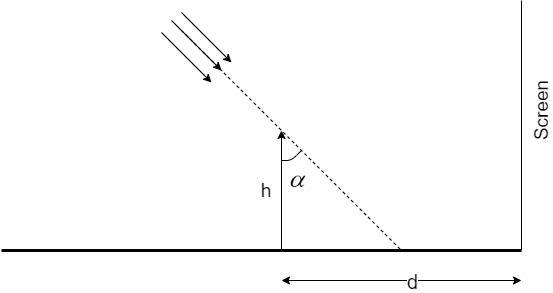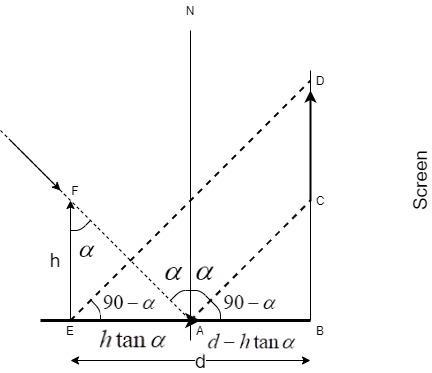
A long horizontal mirror is next to a vertical screen (see figure). Parallel light rays are falling on the mirror at an angle $\alpha $ from the vertical. If a vertical object of height h is kept on the mirror at a distance $d > h\tan \alpha $, the length of the shadow of the object on the screen would be.

A. $\dfrac{h}{2}$
B. $h\tan \alpha $
C. $h$
D. $4h$
Answer
140.1k+ views
Hint: To solve this problem, we have to understand two important concepts and apply them in our problem:
i) Law of reflection: The incident angle is equal to the reflected angle.
$\angle i = \angle r$
ii) The trigonometric ratio, $\tan \theta $ is the ratio of the opposite side of the angle and its adjacent side. $\tan \theta = \dfrac{{Opposite}}{{Adjacent}}$
Complete step by step answer:
The law of reflection states that the incident angle is equal to the reflected angle.
The object of height h is placed on the mirror. The shadow of the object falls on the mirror and the same shadow is reflected back on the screen
The corresponding geometry for the same is given in this figure:

Let us understand the formation of the above geometry in detail.
When the object shadow falls on the mirror at the points A and E, it undergoes a reflection on the plane mirror and an image CD is formed on the screen.
At point A, we have a normal N. The angle made by the ray FA is equal to $\alpha $ since the lines EE and AN are parallel lines and AF is the transverse line, which makes the angles AFE and FAN alternate angles which are equal.
At point A, the incident angle is equal to $\alpha $. Hence, the reflection angle NAD should also be equal to $\alpha $ by the law of the reflection.
Since N is the normal, the angle NAB being equal to 90, the angle CAB = $90 - \alpha $
Since AC is parallel to ED, $\angle DEB = \angle CAB = 90 - \alpha \because $ corresponding angles.
In the triangle AEF,
$\tan \alpha = \dfrac{{Opposite}}{{Adjacent}} = \dfrac{{AE}}{{EF}} = \dfrac{{AE}}{h}$
Thus, $AE = h\tan \alpha $
Given that, AE + AB = d
$AB = d - AE = d - h\tan \alpha $
To calculate the length of the shadow, we need to consider two triangles ABC and EBD to calculate the value of the length CD which is our required value.
In triangle ABC,
$\tan \left( {90 - \alpha } \right) = \dfrac{{BC}}{{AB}} = \dfrac{{BC}}{{d - h\tan \alpha }}$
The trigonometrical identity equal to $\tan \left( {90 - \theta } \right)$ is equal to another identity called $\cot \theta $, where –
$\cot \theta = \dfrac{1}{{\tan \theta }}$
Hence,
$\cot \alpha = \dfrac{{BC}}{{d - h\tan \alpha }}$
In triangle EBD,
$\tan \left( {90 - \alpha } \right) = \dfrac{{BD}}{{EB}} = \dfrac{{BD}}{d}$
The trigonometrical identity equal to $\tan \left( {90 - \theta } \right)$ is equal to another identity called $\cot \theta $, where –
$\cot \theta = \dfrac{1}{{\tan \theta }}$
Hence,
$\cot \alpha = \dfrac{{BD}}{d}$
By equating the values of $\cot \alpha $ in the above triangles,
$\dfrac{{BC}}{{d - h\tan \alpha }} = \dfrac{{BD}}{d}$
$ \Rightarrow BC \times d = BD \times \left( {d - h\tan \alpha } \right)$
$ \Rightarrow BC \times d = BD \times d - BD \times h\tan \alpha $
$ \Rightarrow BD \times h\tan \alpha = d\left( {BD - BC} \right)$
The required length, $CD = BD - BC$
Substituting the value of CD and the value of $BC = \left( {d - h\tan \alpha } \right)\left( {\cot \alpha } \right)$, we get –
$\left( {CD + BC} \right)h\tan \alpha = d \times CD$
$\left( {CD + \cot \alpha \left( {d - h\tan \alpha } \right)} \right)h\tan \alpha = d \times CD$
$ \Rightarrow CD\left( {h\tan \alpha } \right) + h\cot \alpha \tan \alpha \left( {d - h\tan \alpha } \right) = d \times CD$
Since $\cot \alpha = \dfrac{1}{{\tan \alpha }}$
$\cot \alpha \tan \alpha = 1$
Thus,
$ \Rightarrow CD\left( {h\tan \alpha } \right) + h\left( {d - h\tan \alpha } \right) = d \times CD$
$ \Rightarrow CD\left( {h\tan \alpha - d} \right) = h\left( {h\tan \alpha - d} \right)$
$ \Rightarrow CD = \dfrac{{h\left( {h\tan \alpha - d} \right)}}{{\left( {h\tan \alpha - d} \right)}} = h$
Hence, the length of the shadow on the screen, CD = h
Hence, the correct option is Option C.
Note: In this answer, the concept of alternate and corresponding angles are directly applied here. Let us briefly understand them.

A and B are two parallel lines and the line C which intercepts them at an angle is called the transverse line. When a transverse line intercepts the parallel lines, we get several sets of angles.
Here, angles a are called corresponding angle pair and angles b are called alternate angle pair. The relation between them is $a + b = {180^ \circ }$
ii) The trigonometric ratio, $\tan \theta $ is the ratio of the opposite side of the angle and its adjacent side. $\tan \theta = \dfrac{{Opposite}}{{Adjacent}}$
Complete step by step answer:
The law of reflection states that the incident angle is equal to the reflected angle.
The object of height h is placed on the mirror. The shadow of the object falls on the mirror and the same shadow is reflected back on the screen
The corresponding geometry for the same is given in this figure:

Let us understand the formation of the above geometry in detail.
When the object shadow falls on the mirror at the points A and E, it undergoes a reflection on the plane mirror and an image CD is formed on the screen.
At point A, we have a normal N. The angle made by the ray FA is equal to $\alpha $ since the lines EE and AN are parallel lines and AF is the transverse line, which makes the angles AFE and FAN alternate angles which are equal.
At point A, the incident angle is equal to $\alpha $. Hence, the reflection angle NAD should also be equal to $\alpha $ by the law of the reflection.
Since N is the normal, the angle NAB being equal to 90, the angle CAB = $90 - \alpha $
Since AC is parallel to ED, $\angle DEB = \angle CAB = 90 - \alpha \because $ corresponding angles.
In the triangle AEF,
$\tan \alpha = \dfrac{{Opposite}}{{Adjacent}} = \dfrac{{AE}}{{EF}} = \dfrac{{AE}}{h}$
Thus, $AE = h\tan \alpha $
Given that, AE + AB = d
$AB = d - AE = d - h\tan \alpha $
To calculate the length of the shadow, we need to consider two triangles ABC and EBD to calculate the value of the length CD which is our required value.
In triangle ABC,
$\tan \left( {90 - \alpha } \right) = \dfrac{{BC}}{{AB}} = \dfrac{{BC}}{{d - h\tan \alpha }}$
The trigonometrical identity equal to $\tan \left( {90 - \theta } \right)$ is equal to another identity called $\cot \theta $, where –
$\cot \theta = \dfrac{1}{{\tan \theta }}$
Hence,
$\cot \alpha = \dfrac{{BC}}{{d - h\tan \alpha }}$
In triangle EBD,
$\tan \left( {90 - \alpha } \right) = \dfrac{{BD}}{{EB}} = \dfrac{{BD}}{d}$
The trigonometrical identity equal to $\tan \left( {90 - \theta } \right)$ is equal to another identity called $\cot \theta $, where –
$\cot \theta = \dfrac{1}{{\tan \theta }}$
Hence,
$\cot \alpha = \dfrac{{BD}}{d}$
By equating the values of $\cot \alpha $ in the above triangles,
$\dfrac{{BC}}{{d - h\tan \alpha }} = \dfrac{{BD}}{d}$
$ \Rightarrow BC \times d = BD \times \left( {d - h\tan \alpha } \right)$
$ \Rightarrow BC \times d = BD \times d - BD \times h\tan \alpha $
$ \Rightarrow BD \times h\tan \alpha = d\left( {BD - BC} \right)$
The required length, $CD = BD - BC$
Substituting the value of CD and the value of $BC = \left( {d - h\tan \alpha } \right)\left( {\cot \alpha } \right)$, we get –
$\left( {CD + BC} \right)h\tan \alpha = d \times CD$
$\left( {CD + \cot \alpha \left( {d - h\tan \alpha } \right)} \right)h\tan \alpha = d \times CD$
$ \Rightarrow CD\left( {h\tan \alpha } \right) + h\cot \alpha \tan \alpha \left( {d - h\tan \alpha } \right) = d \times CD$
Since $\cot \alpha = \dfrac{1}{{\tan \alpha }}$
$\cot \alpha \tan \alpha = 1$
Thus,
$ \Rightarrow CD\left( {h\tan \alpha } \right) + h\left( {d - h\tan \alpha } \right) = d \times CD$
$ \Rightarrow CD\left( {h\tan \alpha - d} \right) = h\left( {h\tan \alpha - d} \right)$
$ \Rightarrow CD = \dfrac{{h\left( {h\tan \alpha - d} \right)}}{{\left( {h\tan \alpha - d} \right)}} = h$
Hence, the length of the shadow on the screen, CD = h
Hence, the correct option is Option C.
Note: In this answer, the concept of alternate and corresponding angles are directly applied here. Let us briefly understand them.

A and B are two parallel lines and the line C which intercepts them at an angle is called the transverse line. When a transverse line intercepts the parallel lines, we get several sets of angles.
Here, angles a are called corresponding angle pair and angles b are called alternate angle pair. The relation between them is $a + b = {180^ \circ }$
Recently Updated Pages
Young's Double Slit Experiment Step by Step Derivation

Difference Between Circuit Switching and Packet Switching

Difference Between Mass and Weight

JEE Main Participating Colleges 2024 - A Complete List of Top Colleges

JEE Main Maths Paper Pattern 2025 – Marking, Sections & Tips

Sign up for JEE Main 2025 Live Classes - Vedantu

Trending doubts
JEE Main 2025 Session 2: Application Form (Out), Exam Dates (Released), Eligibility, & More

JEE Main 2025: Derivation of Equation of Trajectory in Physics

A point charge + 20mu C is at a distance 6cm directly class 12 physics JEE_Main

JEE Main Exam Marking Scheme: Detailed Breakdown of Marks and Negative Marking

Learn About Angle Of Deviation In Prism: JEE Main Physics 2025

Electric Field Due to Uniformly Charged Ring for JEE Main 2025 - Formula and Derivation

Other Pages
JEE Advanced Marks vs Ranks 2025: Understanding Category-wise Qualifying Marks and Previous Year Cut-offs

JEE Main 2025: Conversion of Galvanometer Into Ammeter And Voltmeter in Physics

Degree of Dissociation and Its Formula With Solved Example for JEE

Electric field due to uniformly charged sphere class 12 physics JEE_Main

Dual Nature of Radiation and Matter Class 12 Notes: CBSE Physics Chapter 11

Formula for number of images formed by two plane mirrors class 12 physics JEE_Main




